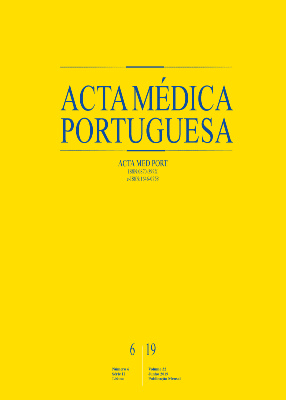Evidence Associated with the Use of Oxazolidinones for the Treatment of Skin and Skin Structure Infections: A Retrospective Study
DOI:
https://doi.org/10.20344/amp.11494Keywords:
Hospitalization, Oxazolidinones, Skin Diseases, Bacterial/drug therapy, Soft Tissue Infections/drug therapyAbstract
Introduction: Skin and skin structure infections are an increasing cause of hospitalization. Although mortality is relatively low, skin and skin structure infections are associated with prolonged hospital length of stay and high costs. Oxazolidinones have been suggested as a tool to treat infected patients in the ambulatory setting in order to decrease hospital length of stay. We wanted to address the evidence associated with the use of oxazolidinones in the treatment of skin and skin structure infections.
Material and Methods: In this observational retrospective study we analyzed the anonymized diagnosis related group coded information from the Portuguese database for hospital admissions, that included all adult patients with a diagnosis of oxazolidinone use and a SSSI, discharged between 2010 and 2015.
Results: During the study period, a total of 5518 patients had a diagnosis of oxazolidinone treatment. We selected 483 of those who were also diagnosed with a skin and skin structure infections. Their mean age was 64.9 years and 62.7% were male. The median hospital length of stay was 27 days (Inter quartile range 13 – 56) and the mortality rate was 12.6%. The prevalence of secondary anemia and of thrombocytopenia in the whole group treated with oxazolidinones was 2.5% and 3%, respectively.
Discussion: Despite the high bioavailability of oxazolidinones, we were not able to find evidence that its use was associated with a decrease of mortality or hospital length of stay (due to early discharge) of patients with skin and skin structure infections.
Conclusion: In this study we were not able to find evidence that oxazolidinones had any clinically significant benefit. A structured approach, including antibiotics with favorable pharmacokinetic and safety profile as well as a carefully planned ambulatory follow up may be needed.
Downloads
Downloads
Published
How to Cite
Issue
Section
License
All the articles published in the AMP are open access and comply with the requirements of funding agencies or academic institutions. The AMP is governed by the terms of the Creative Commons ‘Attribution – Non-Commercial Use - (CC-BY-NC)’ license, regarding the use by third parties.
It is the author’s responsibility to obtain approval for the reproduction of figures, tables, etc. from other publications.
Upon acceptance of an article for publication, the authors will be asked to complete the ICMJE “Copyright Liability and Copyright Sharing Statement “(http://www.actamedicaportuguesa.com/info/AMP-NormasPublicacao.pdf) and the “Declaration of Potential Conflicts of Interest” (http:// www.icmje.org/conflicts-of-interest). An e-mail will be sent to the corresponding author to acknowledge receipt of the manuscript.
After publication, the authors are authorised to make their articles available in repositories of their institutions of origin, as long as they always mention where they were published and according to the Creative Commons license.









